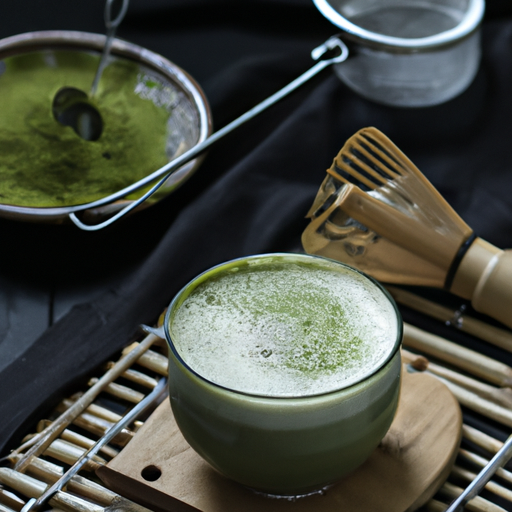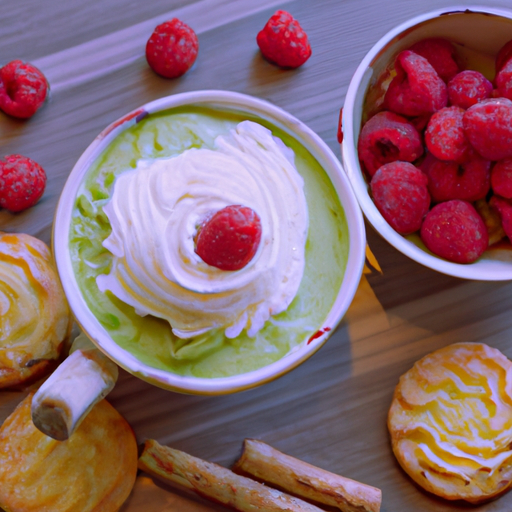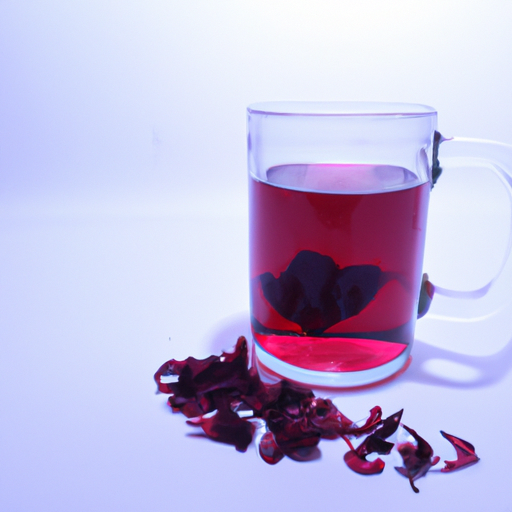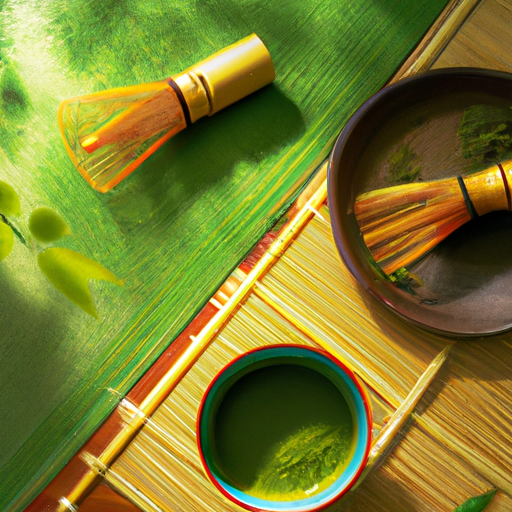Matcha tea has been a part of my daily routine for many years. It not only gives me a natural energy boost, but also comes with various health benefits. Despite my love for the earthy taste of matcha, I often think about ways to elevate its flavor for a more enjoyable experience.
If you’re also a fan of matcha tea but find yourself wanting to switch up its taste, you’re in luck. In this article, I’ll be sharing some natural ingredients that you can add to your matcha tea to make it taste better.
From sweeteners and spices to fruits and herbs, there are plenty of options to choose from that will enhance the flavor of your matcha tea without compromising its health benefits.
Key Takeaways
- Matcha tea is a type of green tea traditionally used in Japanese tea ceremonies, which can provide a natural boost of energy and offer a range of health benefits.
- Adding natural sweeteners like honey, maple syrup, stevia, agave nectar, or fruit juices can enhance the flavor without compromising its health benefits, while milk or non-dairy alternatives like coconut milk or almond milk can add a creamy richness.
- Spices like cinnamon, ginger, cardamom, black pepper, and turmeric can add warmth, depth, and balance out the bitterness of the tea, while fruits, juices, herbs, flowers, and nut butters can add unique flavors and aromas.
- Experimenting with different ingredients and flavor combinations can help in creating a unique flavor profile that suits one’s taste preferences.
The Benefits of Drinking Matcha Tea
If you’re looking for a delicious and healthy drink, drinking matcha tea can provide you with numerous benefits! Matcha tea is a type of green tea that is traditionally used in Japanese tea ceremonies. It is made from finely ground green tea leaves that are mixed with hot water, creating a frothy and vibrant green drink.
One of the main health benefits of matcha tea is its high concentration of antioxidants. Antioxidants are compounds that protect our bodies from damage caused by free radicals, which can lead to chronic diseases such as cancer and heart disease. Matcha tea is particularly rich in a type of antioxidant called catechins, which have been shown to have powerful cancer-fighting properties.
In addition to its health benefits, matcha tea also has cultural significance in Japan. It has been used in tea ceremonies for centuries and is considered a symbol of Japanese hospitality and respect. Drinking matcha tea can be a calming and meditative experience, helping to reduce stress and promote relaxation.
Now that we know about the health benefits and cultural significance of matcha tea, let’s explore some natural sweeteners that can be added to enhance its flavor.
Natural Sweeteners to Add to Matcha Tea
Although some may argue that adding natural sweeteners to matcha tea is sacrilegious, there is no denying that a touch of honey or maple syrup can elevate the flavor profile. Matcha tea can be quite bitter on its own, and those who are new to the drink may find it difficult to enjoy. Adding natural sweeteners is a great way to make the tea more palatable and enjoyable.
When it comes to natural sweeteners, there are a variety of options to choose from. Honey and maple syrup are popular choices, but you can also add stevia, agave nectar, or even fruit juices to your matcha tea. When deciding on which sweetener to use, consider the flavor profile you want to achieve. For example, honey can add a floral sweetness, while maple syrup can add a rich, earthy sweetness.
To help you find the perfect natural sweetener for your matcha tea, here is a table of flavor combinations to consider:
| Sweetener | Flavor Profile | Best Matcha Tea Flavor |
|---|---|---|
| Honey | Floral | Ceremonial Grade |
| Maple Syrup | Earthy | Culinary Grade |
| Agave Nectar | Mild and Sweet | Any Grade |
| Fruit Juice | Fruity | Any Grade |
Adding natural sweeteners to matcha tea is a great way to enhance the flavor and make it more enjoyable. However, if you prefer a creamier texture, you may want to consider adding milk or non-dairy alternatives.
Milk and Non-Dairy Alternatives
Now, let’s explore how adding milk or non-dairy alternatives can bring a creamy richness to your matcha tea that’ll leave you feeling satisfied and indulged.
One popular way to incorporate milk into matcha tea is by making a matcha latte. To do this, add matcha powder to a cup and whisk in a small amount of hot water. Then, heat up milk (or a non-dairy alternative) in a separate pan until it reaches your desired temperature. Pour the milk over the matcha mixture and stir well. This will create a frothy and creamy texture that complements the earthy flavor of matcha.
If you prefer a non-dairy alternative, coconut milk or almond milk can be used instead of regular dairy milk. Both coconut and almond milk have a natural sweetness that pairs well with matcha, and their creamy texture makes for a satisfying beverage. To use these alternatives in a matcha latte, simply follow the same steps as above. Heat up the milk in a separate pan before pouring it over the matcha mixture.
Adding milk or non-dairy alternatives is a great way to enhance the flavor and texture of matcha tea. However, if you’re looking for a more unique and flavorful experience, consider adding spices to your matcha. Adding spices like cinnamon or ginger can add a warming element to your matcha tea, while cardamom can add a floral note. These spices can also help balance out the bitterness of matcha, making it even more enjoyable to drink.
Spices to Add to Matcha Tea
Don’t hesitate to experiment with spices in your matcha, as they can elevate your drinking experience and bring a new dimension of flavor to your cup. Spice blends like cinnamon, nutmeg, and cardamom can add warmth and depth to your matcha. These spices are commonly used in baking and cooking, but they can also be used to enhance the flavor of your matcha tea.
Unconventional pairings like black pepper, ginger, and turmeric can also be added to matcha tea. These spices have a strong flavor profile that can complement the earthy taste of matcha. Black pepper, for example, can add a subtle heat to your matcha, while ginger can add a spicy kick. Turmeric, on the other hand, can add a slightly bitter taste that can balance the sweetness of your matcha.
If you’re feeling adventurous, you can also try adding other spices like cloves, allspice, or even chili powder to your matcha tea. These spices can add a unique twist to your matcha and make it stand out from the usual matcha drinks. Just remember to start with a small amount and adjust to your taste preference.
Adding fruits and juices to your matcha tea can also be a great way to enhance its flavor. By adding fruits like lemon, lime, or orange, you can add a refreshing citrusy taste to your matcha. Juices like apple or pineapple can also add a sweet and tangy flavor to your matcha. So, don’t be afraid to experiment with different flavors and find the perfect matcha drink for you.
Fruits and Juices
To truly elevate your matcha experience, consider adding fruits and juices for a refreshing twist that’ll leave your taste buds feeling invigorated.
Blending with tea is a great way to enhance the natural sweetness of your matcha. For instance, adding a splash of peach or mango juice can give your matcha a fruity kick that balances out its earthy flavor. You can also try blending your matcha with lemon or lime juice for a tangy twist that adds a refreshing zing to your drink.
Adding syrups to your matcha can also be a game-changer. A drizzle of honey or agave syrup can lend your matcha a natural sweetness that’s hard to resist. You can also try adding a dash of vanilla syrup to your matcha for a decadent treat that’s perfect for a cozy night in. If you’re feeling adventurous, try adding some coconut or almond milk to your matcha for a creamy and indulgent twist.
While fruits and syrups are a great way to enhance your matcha, you can also try experimenting with herbs and flowers to take your matcha game to the next level.
But before we dive into that, let’s explore some other ways to enhance the flavor of your matcha.
Herbs and Flowers
I’m excited to discuss the use of herbs and flowers in matcha tea. They can add unique flavors and aromas to the beverage. Mint is a popular choice because it adds a refreshing and cooling sensation to the drink.
Lavender can provide a floral and calming note, while rose petals can add a delicate sweetness to the tea. Experimenting with different herbs and flowers can be a fun way to enhance the flavor profile of matcha tea.
Mint
Adding a touch of mint to matcha tea can enhance the overall flavor profile and provide a refreshing twist. There are several mint variations that can be used to complement matcha tea, such as peppermint, spearmint, and chocolate mint. Each variation has a distinct flavor profile, with peppermint providing a strong and cooling taste, spearmint offering a sweeter and subtler taste, and chocolate mint adding a chocolatey undertone to the tea.
When it comes to pairing suggestions, mint can be combined with various ingredients to create a unique and flavorful matcha tea blend. For instance, mint and lemon can be added to matcha tea for a citrusy and refreshing taste, while mint and honey can be used for a sweeter and smoother flavor. Additionally, mint and ginger can be combined with matcha tea to create a spicy yet refreshing blend. With its versatility and array of flavor profiles, mint is a great ingredient to experiment with when making matcha tea.
Moving forward to the next subtopic, lavender can also be used to elevate the taste of matcha tea.
Lavender
Hey, have you ever tried adding a pinch of lavender to your matcha latte? It can give your drink a subtle floral flavor that’s perfect for a relaxing afternoon break.
Not only that, but using lavender in baking and lavender-infused drinks for relaxation have become quite popular lately. Lavender has a distinct aroma and flavor that can add a unique touch to your matcha tea.
It’s also known for its calming properties, making it an excellent addition to your drink if you’re looking to unwind after a long day. You can easily make lavender-infused milk by heating up milk with dried lavender flowers and letting it steep for a few minutes before straining it.
Then, simply add the lavender-infused milk to your matcha tea and enjoy a calming and delicious drink. As for using rose, it’s another great addition to matcha tea that can give it a floral and slightly sweet flavor.
Instead of using dried rose petals, you can make a rose syrup by simmering fresh rose petals with sugar and water until it thickens. Then, add a teaspoon or two of the syrup to your matcha tea for a delicious and fragrant drink.
Rose
Indulging in a rose-infused matcha latte can add a delicate and fragrant flavor to your daily cup of tea. The combination of the slightly bitter matcha and the floral essence of rose creates a unique and refreshing taste that is sure to please your palate.
To make a rose-infused matcha latte, simply mix together matcha powder, hot water, and rose syrup, then add steamed milk of your choice.
Another way to incorporate rose into your matcha routine is by making a rose petal matcha smoothie. Blend together frozen bananas, almond milk, matcha powder, and a handful of fresh or dried rose petals to create a creamy and nutritious drink. The sweet and earthy taste of the banana pairs perfectly with the floral notes of the rose, while the matcha powder provides a boost of energy and focus.
Now, let’s move on to the next section about adding nut butters to your matcha for a creamy and nutty twist.
Nut Butters
Using nut butters in matcha tea can transform the flavor profile, creating a creamy and nutty taste that enhances the natural earthiness of the tea.
Peanut butter and almond butter are two popular options to add to matcha tea, but any nut butter can be used.
When adding nut butter to matcha tea, it’s important to mix it well to ensure the flavors are evenly distributed.
To make a delicious nut butter matcha tea, start by preparing the matcha tea according to your preference.
Once the tea is prepared, add a spoonful of nut butter to the hot tea and mix well until it’s fully incorporated.
You can adjust the amount of nut butter to your liking, but be mindful that a little goes a long way.
If you want to take your nut butter matcha tea to the next level, try adding a pinch of cinnamon or a drizzle of honey.
These additions can complement the nutty flavor and enhance the overall taste of the tea.
With these simple additions, you can create a delicious and unique matcha tea that’s sure to satisfy your taste buds.
Adding vanilla extract to matcha tea can also be a great way to enhance the flavor profile.
By adding just a few drops of vanilla extract, you can create a subtle sweetness that complements the earthy taste of the matcha.
Vanilla Extract
Adding a few drops of vanilla extract to your matcha can transport you to a cozy, warm kitchen filled with the sweet aroma of baked goods. Vanilla extract is a popular flavor enhancer used in a variety of recipes, and it can work wonders in your matcha tea too.
It adds a subtle sweetness and depth of flavor to your cup, making it taste more delicious and satisfying. When using vanilla extract in matcha, it’s important to add it in moderation, as a little goes a long way. Start with just a few drops and adjust to your taste preference.
You can also experiment with other flavor extracts, such as almond, peppermint, or caramel, to create a unique and personalized matcha experience. However, it’s important to keep the balance of flavors in mind to avoid overpowering the delicate taste of matcha.
Incorporating vanilla extract or other flavor extracts to your matcha can be a fun and delicious way to experiment with flavors. It’s a great way to switch up your routine and add some excitement to your daily cup of matcha. However, remember to use these flavor enhancers in moderation and experiment with caution to find the perfect balance of flavors in your cup.
Experimenting with Flavors
Get creative with your matcha and explore the endless possibilities of flavor combinations to elevate your tea experience. Experimenting with flavors can be a fun and exciting way to add variety to your matcha routine.
By adding different ingredients, you can enhance the taste of your matcha and create a unique flavor profile that suits your taste buds. One way to experiment with flavors is by taste testing. You can start by adding a small amount of a flavor to your matcha, such as honey, ginger, or cinnamon. Mix the ingredients well and taste the result.
If you find the combination to be too overpowering, adjust the amount or try a different flavor. Keep experimenting until you find the perfect combination that suits your taste. Another way to experiment with flavors is by trying out different flavor combinations.
For example, you can add vanilla extract and almond milk to your matcha for a sweet and nutty flavor. Or you can add mint leaves and lemon for a refreshing and citrusy taste. The possibilities are endless, so don’t be afraid to get creative and try out different flavor combinations to find your perfect matcha recipe.
Frequently Asked Questions
How is matcha tea different from regular green tea?
As the adage goes, "all that glitters is not gold,"and the same can be said for green teas.
Matcha tea differs significantly from regular green tea in terms of both its preparation and its health benefits. Unlike traditional green tea, which is made by steeping tea leaves in hot water, matcha tea is made using ground, shade-grown green tea leaves, which are then whisked into a frothy, bright green liquid.
This unique preparation results in a tea that is richer in antioxidants and other beneficial compounds than traditional green tea. Matcha tea has been shown to help boost metabolism, improve cognitive function, and even lower the risk of certain types of cancer.
There are also many delicious matcha tea recipes out there that can help you enjoy the many benefits of this tea in new and exciting ways. Whether you prefer a classic matcha latte or a matcha-infused smoothie, there are countless ways to incorporate this healthy and delicious tea into your daily routine.
Does matcha tea contain caffeine?
Matcha tea does contain caffeine, but the amount may vary depending on the type of matcha and how it was prepared. Generally, one cup of matcha tea contains approximately 70mg of caffeine, which is roughly equivalent to a cup of coffee.
Despite its caffeine content, matcha tea also offers numerous health benefits. It’s rich in antioxidants, which can help to reduce inflammation and prevent cell damage. Additionally, matcha tea has been shown to boost metabolism and promote relaxation, making it a great option for those who want to stay alert and focused without feeling jittery.
Overall, matcha tea is a great choice for anyone looking for a healthy and energizing beverage.
Can matcha tea help with weight loss?
Matcha tea is known to have several benefits, including aiding in weight loss. It contains a high concentration of antioxidants and other compounds that help to boost metabolism and burn fat. Additionally, matcha tea is known to increase the body’s energy levels, which can help to promote physical activity and weight loss.
There are also several matcha tea recipes that can be used to enhance the taste of the tea, such as adding honey, almond milk, or cinnamon. However, it’s important to note that these additions may also add calories to the tea and should be used in moderation if weight loss is a goal.
How do I properly prepare matcha tea?
Before diving into the various flavoring options for matcha tea, it’s important to understand how to properly prepare it.
To begin, sift one teaspoon of matcha powder into a bowl. Slowly pour in 2 ounces of hot water that’s just below boiling, then use a bamboo whisk to vigorously whisk the mixture in a zig-zag motion until it becomes frothy. The key is to not let the matcha settle on the bottom of the bowl.
Now that you know the basics of matcha tea preparation, you may be wondering how to enhance its flavor. Some popular options include adding honey or agave for sweetness, coconut milk or almond milk for creaminess, or even a dash of cinnamon or vanilla extract for some added warmth and depth. Experiment with different flavoring options to find the perfect matcha tea blend that suits your taste buds.
Are there any potential side effects of drinking matcha tea?
As someone who drinks matcha tea regularly, I’m aware of the potential side effects that can come with consuming it in excess.
While matcha tea is known for its detoxifying effects and high antioxidant content, it also contains caffeine which can lead to jitters, headaches, and difficulty sleeping if consumed in large quantities.
It’s recommended to stick to a moderate daily intake of 1-2 cups of matcha tea per day to avoid any negative side effects.
It’s important to note that adding sweeteners or milk to matcha tea can increase its calorie and sugar content, so it’s best to enjoy it on its own or with a touch of honey or lemon for added flavor.
Conclusion
In conclusion, I’ve learned that there are numerous ways to enhance the taste of matcha tea. Not only does matcha provide a plethora of health benefits, but it’s also a versatile ingredient that can be customized to one’s personal taste preferences.
Whether you prefer a sweeter taste or a more savory flavor, there are natural sweeteners, spices, fruits, and other ingredients that can be added to matcha tea to make it taste better.
As the saying goes, "variety is the spice of life,"and this certainly holds true when it comes to matcha tea. By experimenting with different flavors, we can elevate the taste of this healthy beverage and make it a daily ritual that we look forward to.
So, whether you choose to add some honey, vanilla extract, or even a pinch of cayenne pepper, don’t be afraid to get creative and make your matcha tea experience unique to you.










